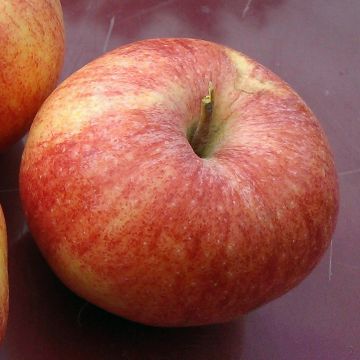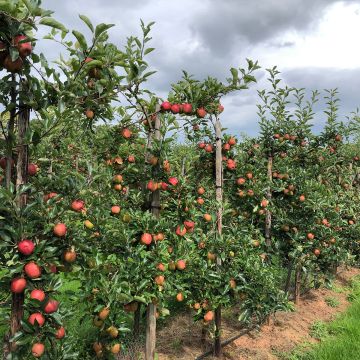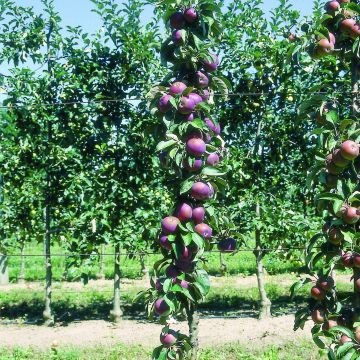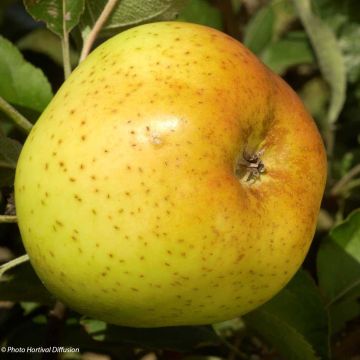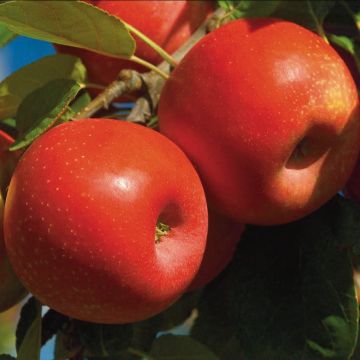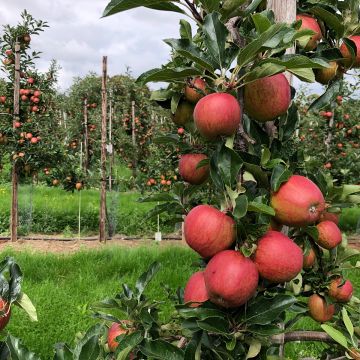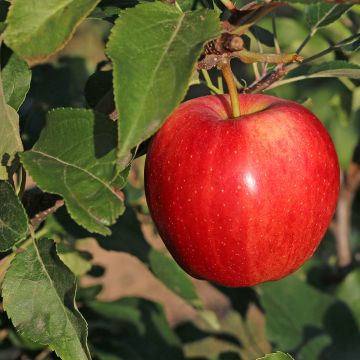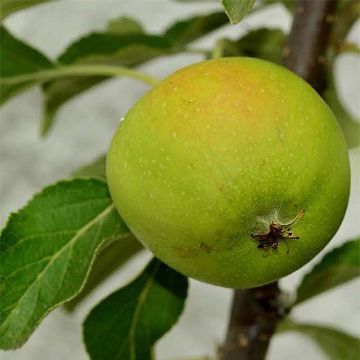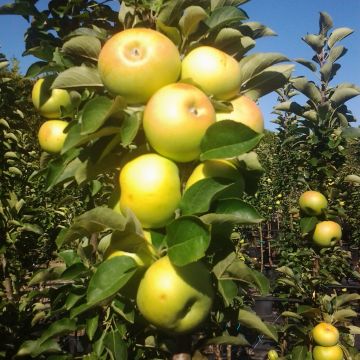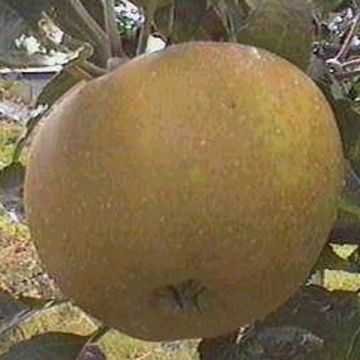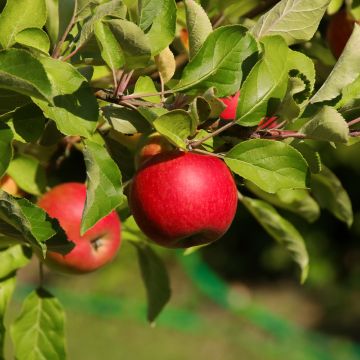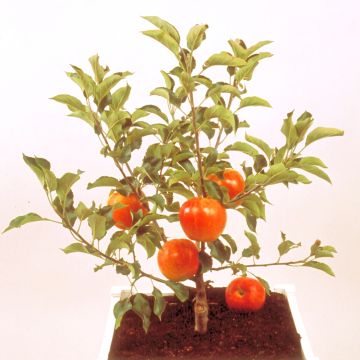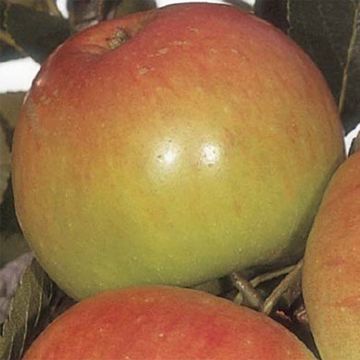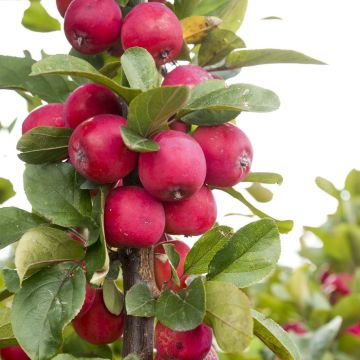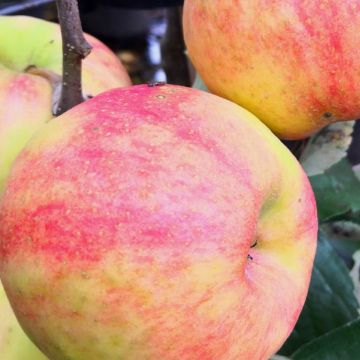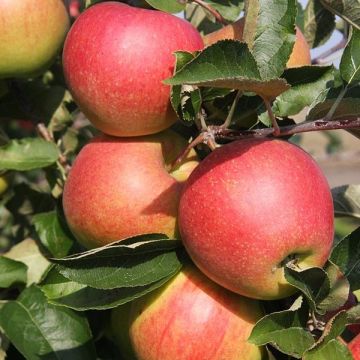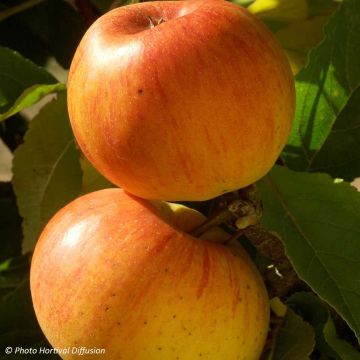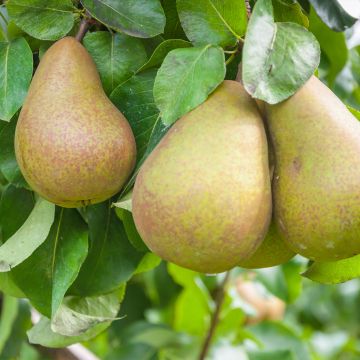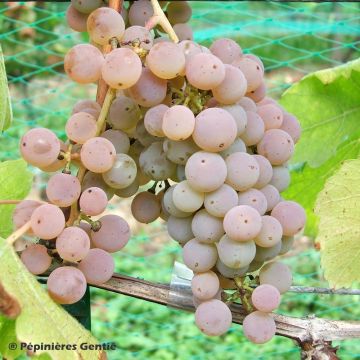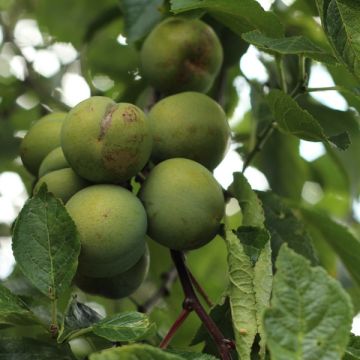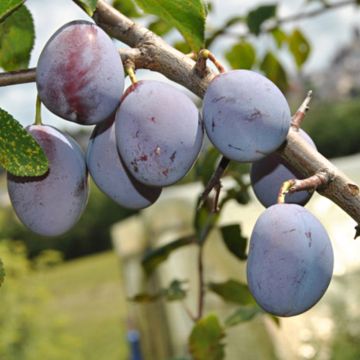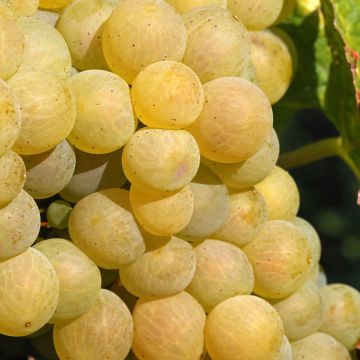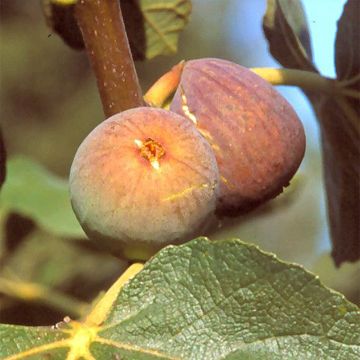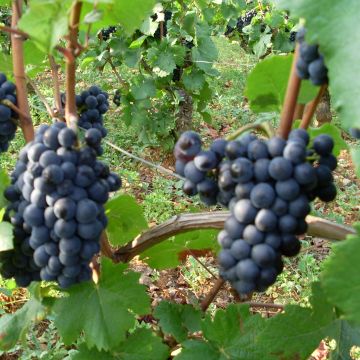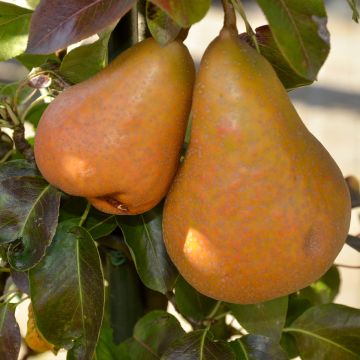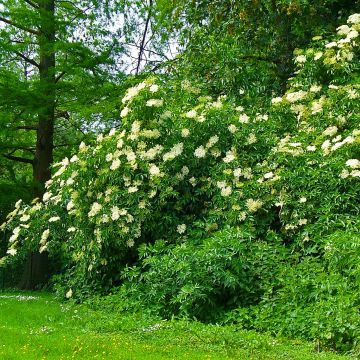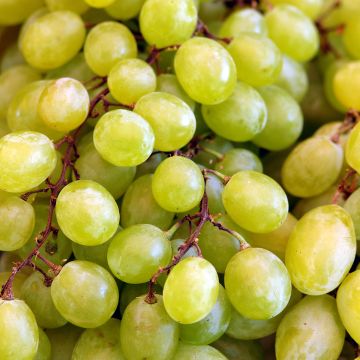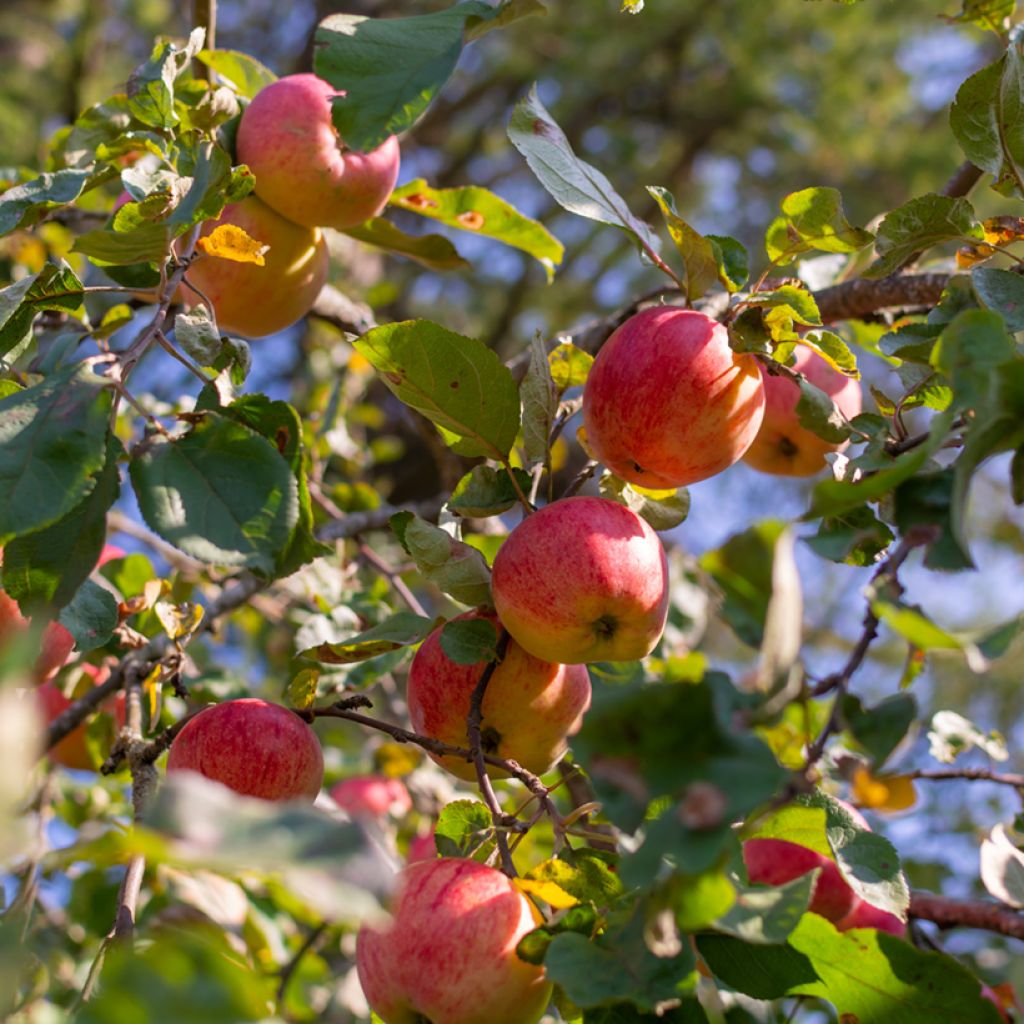

Pommier Belle fille de la Creuse
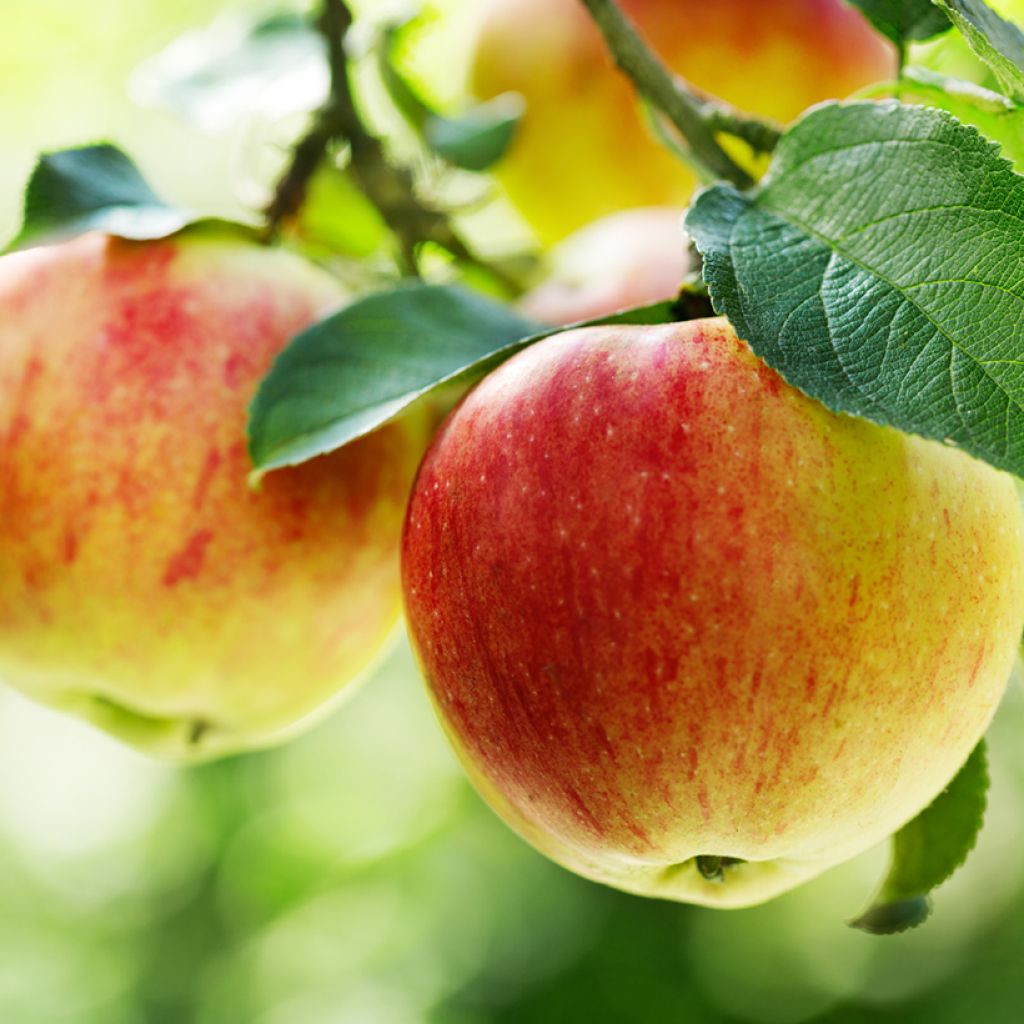

Pommier Belle fille de la Creuse
Organic Apple Tree Belle fille de la Creuse - Malus domestica
Malus domestica Belle Fille de la Creuse
Apple, Orchard apple, Table apple, Cultivated apple
Why not try an alternative variety in stock?
View all →This plant carries a 6 months recovery warranty
More information
We guarantee the quality of our plants for a full growing cycle, and will replace at our expense any plant that fails to recover under normal climatic and planting conditions.
Oversize package: home delivery by special carrier from €6.90 per order..
Express home delivery from €8.90.
Description
The Malus domestica 'Belle Fille de la Creuse' is an old variety known for producing apples that can be stored for a long time and have excellent taste for various culinary uses. It produces an apple of medium to large size, with variable size depending on the number of fruits on the tree, round in shape, flattened at the base, with a regular outline. The skin, smooth and thin, is yellow, washed with red on three-quarters of the fruit, streaked with dark red on almost the entire surface, with few lenticels. Its white flesh is firm, delicate, crisp, juicy, sweet, without acidity and delicately flavoured. Harvesting begins in October; the fruits can be consumed from the end of November and stored until April-May if the harvest is late and if the storage conditions are optimal. It is a self-sterile variety that requires the presence of other apple varieties to ensure pollination.
The Malus domestica, also known as Malus communis or Malus pumila, is commonly called the Common Apple Tree or Domestic Apple Tree. It belongs to the Rosaceae family. Present in France and Europe since ancient times, it is a fruit tree native to the forests of Central Asia. It is highly hardy and is probably the most cultivated fruit tree in Northern Europe. There are about 20,000 varieties, including approximately 10,000 of American origin, 2,000 of English origin, and 2,000 of Chinese origin. The Belle Fille apple tree, also known as Belle Femme, Belle Bourguignonne, has very ancient and poorly known origins from before 1600. There are many variants of 'Belle Fille': from Burgundy, from Indre, from Creuse, from Salins, from Manche, Normande, from Berry. The Belle Fille de la Creuse is found north of Creuse and Haute-Vienne.
The Belle Fille de la Creuse Apple Tree is a spreading tree, reaching approximately 5 metres (16 feet) in height and 4 metres (13 feet) in width when fully grown. Its habit is well suited to low or tall forms and espalier forms. Its foliage consists of large, ovate leaves, greenish-brown on the upper side, whitish-green on the lower side, deeply dentate. The late flowering occurs around early May, which usually protects it from frost. The flowers are destroyed by frost at temperatures below -2 to -3°C. It is suitable for cultivation in all regions with frosts that are not too late. The apple tree is a hardy plant that can withstand temperatures around -20 ° and is suitable for cultivation in all regions. Its abundant white flowering, remarkably decorative in spring, is also highly attractive to bees and provides nectar. Despite its vigour, this variety produces poor-quality pollen, making it very weakly capable of pollinating other apple varieties. It produces apples with few or no fertile seeds. It is said to be self-sterile, which is why the presence of apple trees that bloom at the same time is necessary. Varieties such as Court Pendu, Jacques Lebel, Jonathan, Reine des Reinettes, Reinette du Mans, Reinette Etoilée, Reinette du Canada blanc, Winston, or any other late-flowering variety are suitable for cross-pollination.
The Belle Fille de la Creuse Apple Tree is a vigorous, fertile variety with rapid fruiting. It is extremely productive and reasonably resistant to canker, powdery mildew, and scab.
A crisp, juicy, and sweet apple that can be enjoyed raw or cooked in compotes, pastries, paired with cheese, or as an accompaniment to savoury dishes such as black pudding, pork, or salads. It is also perfect for making juice. Easy to consume, apples provide an incredible feeling of satiety. Rich in carbohydrates and fructose, they are invigorating, energising, and rehydrating. Their high content of vitamins A, B, C, and E, minerals, antioxidants, and fibre makes apples a health asset. The fruits can be stored throughout the winter, even until April if the harvest is late. Storage can be done in a cool, clean place, protected from light around 8 to 10°C or in a cold room, sealed off from outside air at 1 to 3°C. Apples release ethylene, a gas that promotes fruit ripening. Place your apples next to them to accelerate the ripening of other fruits or vegetables.
Very popular for its fruits, the apple tree is a wonderful addition to any garden, bringing joy to both young and old. With a wide range of apple trees, finding the variety that best suits one's desire is easy.
Report an error about the product description
Plant habit
Fruit
Flowering
Foliage
Botanical data
Malus
domestica
Belle Fille de la Creuse
Rosaceae
Apple, Orchard apple, Table apple, Cultivated apple
Cultivar or hybrid
Other Apple trees
Planting and care
Choose a sunny location for your 'Belle Fille de la Creuse' Apple Tree. The soil can be slightly chalky or acidic but not excessively so. Dig a large planting hole at least three times the size of the root ball. Simultaneously, organic matter (topsoil, compost, etc.) and a base fertiliser such as bonemeal should be added. Do not bury the graft collar. Stake if necessary. For apple trees planted in isolation and in open ground, it may be interesting to stake them by installing a guy-wire system: plant three stakes in a triangle shape 50 cm (20in) around the trunk and connect them with pieces of wood. Protect the bark with a piece of rubber, for example, and attach the stakes to the trunk with metal wires. Water abundantly, even in winter, even if it rains. Fruit trees are ideally planted between October and March, outside the frost period. Container-grown plants can be planted all year round except during high heat or frost periods.
In winter, at the tree's base and lightly incorporated into the soil surface, you can add a small handful of wood ash, rich in potash, to improve fruiting. Apple trees can be susceptible to various diseases and pests. To limit risks, space the trees sufficiently and install multi-species hedges, birdhouses or insect hotels to attract beneficial insects. In summary, prioritise diversity. The main diseases of the Apple Tree are scab (brown spots on the leaves), brown rot (wilting of flowers and rotting of fruits on the tree), and powdery mildew (white powdery coating on the leaves). For these three cases, preventive action is preferred by spraying a concoction of horsetail. In severe attacks, you can apply a fungicide as a last resort. As for pests, the codling moth (or fruit worm) is a small caterpillar that causes galleries inside the fruit. To remedy this, it is preferable to act preventively by promoting the establishment of tits and bats through the installation of nest boxes. In case of an aphid attack, spray a solution based on black soap.
During the harvest in September, only keep the picked fruits. For good storage, placing the apple with its stem pointing downwards, on shelves or in crates is advisable. Choose a completely dark, dry, and cool place but frost-free.
Planting period
Intended location
Care
This item has not been reviewed yet - be the first to leave a review about it.
Ancient and local varieties
Haven't found what you were looking for?
Hardiness is the lowest winter temperature a plant can endure without suffering serious damage or even dying. However, hardiness is affected by location (a sheltered area, such as a patio), protection (winter cover) and soil type (hardiness is improved by well-drained soil).

Photo Sharing Terms & Conditions
In order to encourage gardeners to interact and share their experiences, Promesse de fleurs offers various media enabling content to be uploaded onto its Site - in particular via the ‘Photo sharing’ module.
The User agrees to refrain from:
- Posting any content that is illegal, prejudicial, insulting, racist, inciteful to hatred, revisionist, contrary to public decency, that infringes on privacy or on the privacy rights of third parties, in particular the publicity rights of persons and goods, intellectual property rights, or the right to privacy.
- Submitting content on behalf of a third party;
- Impersonate the identity of a third party and/or publish any personal information about a third party;
In general, the User undertakes to refrain from any unethical behaviour.
All Content (in particular text, comments, files, images, photos, videos, creative works, etc.), which may be subject to property or intellectual property rights, image or other private rights, shall remain the property of the User, subject to the limited rights granted by the terms of the licence granted by Promesse de fleurs as stated below. Users are at liberty to publish or not to publish such Content on the Site, notably via the ‘Photo Sharing’ facility, and accept that this Content shall be made public and freely accessible, notably on the Internet.
Users further acknowledge, undertake to have ,and guarantee that they hold all necessary rights and permissions to publish such material on the Site, in particular with regard to the legislation in force pertaining to any privacy, property, intellectual property, image, or contractual rights, or rights of any other nature. By publishing such Content on the Site, Users acknowledge accepting full liability as publishers of the Content within the meaning of the law, and grant Promesse de fleurs, free of charge, an inclusive, worldwide licence for the said Content for the entire duration of its publication, including all reproduction, representation, up/downloading, displaying, performing, transmission, and storage rights.
Users also grant permission for their name to be linked to the Content and accept that this link may not always be made available.
By engaging in posting material, Users consent to their Content becoming automatically accessible on the Internet, in particular on other sites and/or blogs and/or web pages of the Promesse de fleurs site, including in particular social pages and the Promesse de fleurs catalogue.
Users may secure the removal of entrusted content free of charge by issuing a simple request via our contact form.
The flowering period indicated on our website applies to countries and regions located in USDA zone 8 (France, the United Kingdom, Ireland, the Netherlands, etc.)
It will vary according to where you live:
- In zones 9 to 10 (Italy, Spain, Greece, etc.), flowering will occur about 2 to 4 weeks earlier.
- In zones 6 to 7 (Germany, Poland, Slovenia, and lower mountainous regions), flowering will be delayed by 2 to 3 weeks.
- In zone 5 (Central Europe, Scandinavia), blooming will be delayed by 3 to 5 weeks.
In temperate climates, pruning of spring-flowering shrubs (forsythia, spireas, etc.) should be done just after flowering.
Pruning of summer-flowering shrubs (Indian Lilac, Perovskia, etc.) can be done in winter or spring.
In cold regions as well as with frost-sensitive plants, avoid pruning too early when severe frosts may still occur.
The planting period indicated on our website applies to countries and regions located in USDA zone 8 (France, United Kingdom, Ireland, Netherlands).
It will vary according to where you live:
- In Mediterranean zones (Marseille, Madrid, Milan, etc.), autumn and winter are the best planting periods.
- In continental zones (Strasbourg, Munich, Vienna, etc.), delay planting by 2 to 3 weeks in spring and bring it forward by 2 to 4 weeks in autumn.
- In mountainous regions (the Alps, Pyrenees, Carpathians, etc.), it is best to plant in late spring (May-June) or late summer (August-September).
The harvesting period indicated on our website applies to countries and regions in USDA zone 8 (France, England, Ireland, the Netherlands).
In colder areas (Scandinavia, Poland, Austria...) fruit and vegetable harvests are likely to be delayed by 3-4 weeks.
In warmer areas (Italy, Spain, Greece, etc.), harvesting will probably take place earlier, depending on weather conditions.
The sowing periods indicated on our website apply to countries and regions within USDA Zone 8 (France, UK, Ireland, Netherlands).
In colder areas (Scandinavia, Poland, Austria...), delay any outdoor sowing by 3-4 weeks, or sow under glass.
In warmer climes (Italy, Spain, Greece, etc.), bring outdoor sowing forward by a few weeks.

































